The Orsini Polyptych is one of the masterpieces of Simone Martini (Siena, 1284 - Avignon, 1344), one of the masters of Sienese painting in the first half of the 14th century. The physical structure of this work and its small size favored its dismemberment, and the tablets into which it was broken down are now preserved among the Koninklijk Museum voor Schone Kunsten in Antwerp, the Louvre in Paris and the Gemäldegalerie in Berlin.
In order to make the following discourse comprehensible, it is necessary from the outset to talk about the structure of this artifact, because this aspect can provide clues as to the type of patron, the specific function and the iconographic choice: we are in fact dealing with a portable polyptych, that is, an artifact intended for the personal devotion of the patron, easily transportable in case of travel and transfers. This type of object was probably inspired by similar French artifacts made of ivory or precious metal and were within the economic reach of vast groups of people, both religious and secular.
The Orsini Polyptych consists of four wooden tablets painted on both sides, measuring 29.5 by 20.5 centimeters, which had to be assembled “a concertina” by means of hinges, that is, all four tablets folded up to take the shape of a book. At the time it was opened, four scenes from the Passion and Death of Christ unfolded on one side, and on the other was depicted anAnnunciation within the arms of the Orsini family, also present on the faces that remained visible when the polyptych was closed.
The Christological scenes depicted are theGoing to Calvary, the Crucifixion, the Deposition from the Cross, and the Burial: the Orsini family coat of arms, the Virgin Announced, and the Archangel Gabriel are depicted on the verso, respectively. On the verso of the Seppellimento the Orsini coat of arms must have been present again, but it is no longer visible: the one preserved in Berlin is probably the tablet that has undergone the most retouching, and in fact even its measurements are slightly reduced compared to the others due to downsizing. This arrangement of the tablets would seem to be confirmed by the inscription, now fragmentary, on the frames "hoc opus“ on the Louvre tablet, ”pinxit Symon“ on those in Antwerp, and probably on the one in Berlin a similar indication ”de Senis" must have appeared.
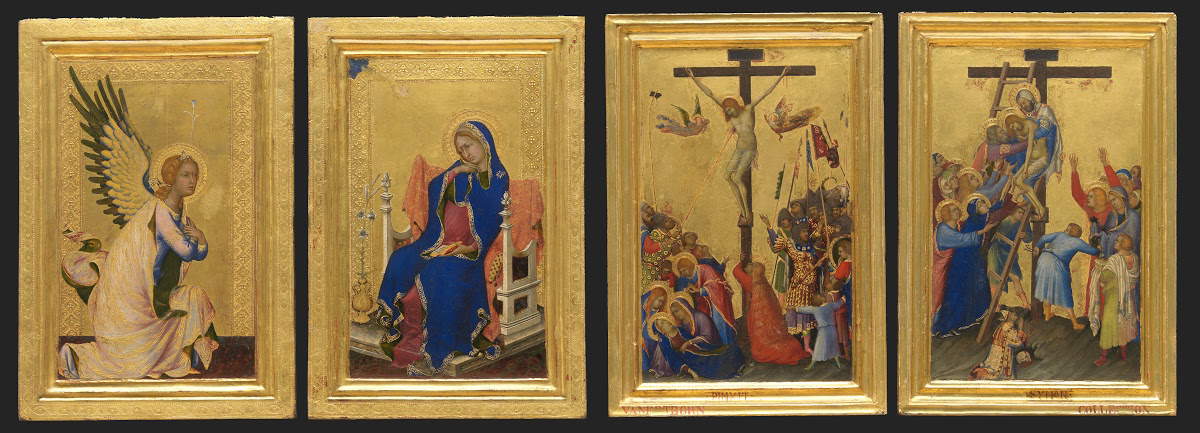 |
| The Antwerp tablets as displayed at the Koninklijk Museum voor Schone Kunsten |
Looking at the overall composition of the four Christ-themed tablets, one notices that the scenes are very crowded. The painter depicts a multiplicity of characters, and not only those essential to the Gospel stories. The compositional continuity between the four scenes is extraordinary; it almost seems as if a single flow drives all the events, from the exit through the gate of Jerusalem in the first panel, to the Cross, to the burial. Another element that already emerges from a first observation is the great emotional charge that the artist imparts to his characters, carefully investigating their reaction to the events.
In the first scene, the one depicting the Going to Calvary, Simone takes up a model already experimented with by Duccio di Buoninsegna in theEntrance to Jerusalem in the back part of the Maestà for Siena Cathedral. Jerusalem is depicted as a typical medieval city, with crenellated walls with the presence of corbels. The building with a central plan is the symbolic indication of the temple of Jerusalem: already from this first scene we can see how Simone Martini, who had made his own the lesson of Giotto’s spatiality since works such as the Maestà frescoed in the Sala del Mappamondo of the Palazzo Pubblico in Siena or the frescoes of the Cappella di San Martino in the Lower Basilica of St. Francis in Assisi, here manages space differently. Indeed, one can see how the spatial relationships are distorted: the people, swamping Christ like a flooding river, seem to be stacked on top of each other as they exit the gate of Jerusalem. However, if at first glance the spatial setting given by Simone to this scene appears inconsistent with the real datum, some precise spatial allusions can be identified instead: for example, the Cross, seen in tralice, is physically present between the hands of Christ and the Cyrenean.
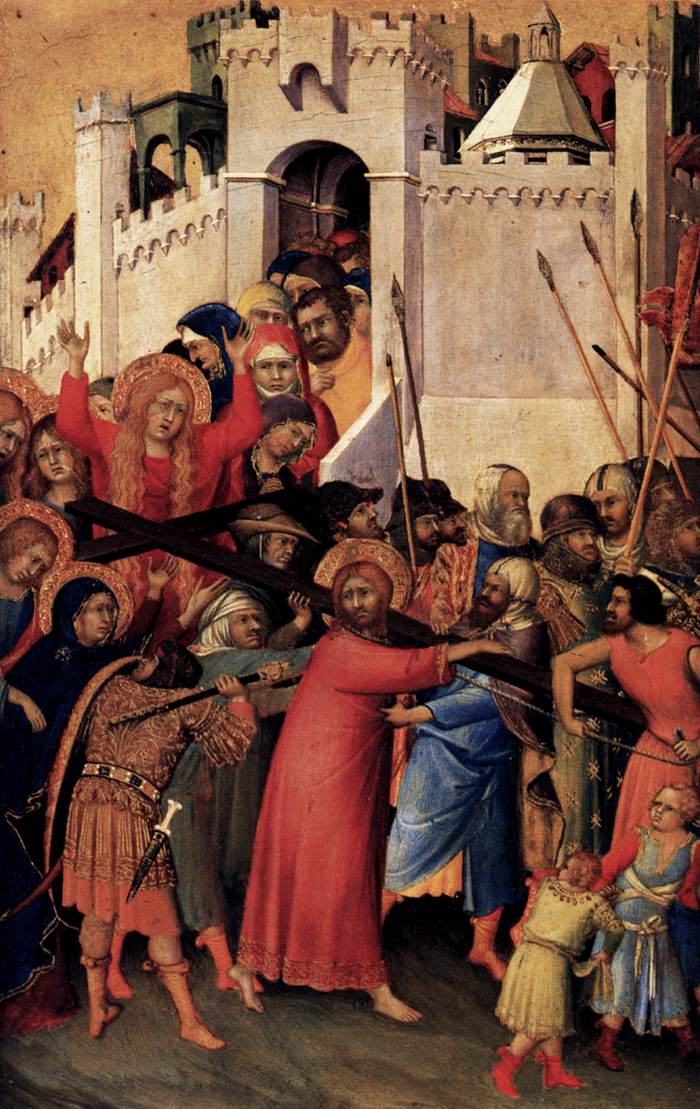 |
| Simone Martini, Going to Calvary, from the Orsini Polyptych (1333-1335; tempera and gold on panel, 29.5 x 20.5 cm; Paris, Louvre) |
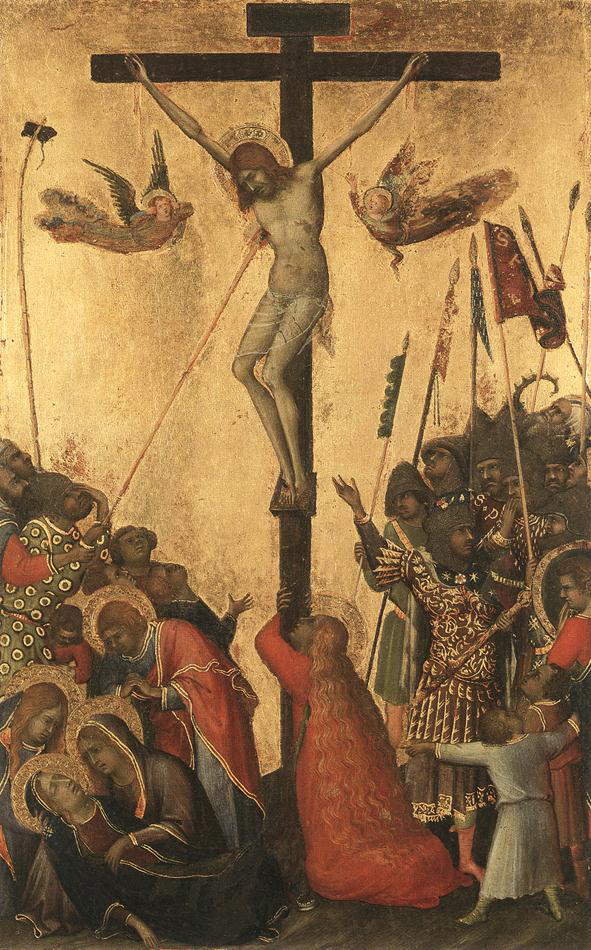 |
| Simone Martini, Crucifixion, from the Orsini Polyptych (1333-1335; tempera and gold on panel, 29.5 x 20.5 cm; Antwerp, Koninklijk Museum voor Schone Kunsten) |
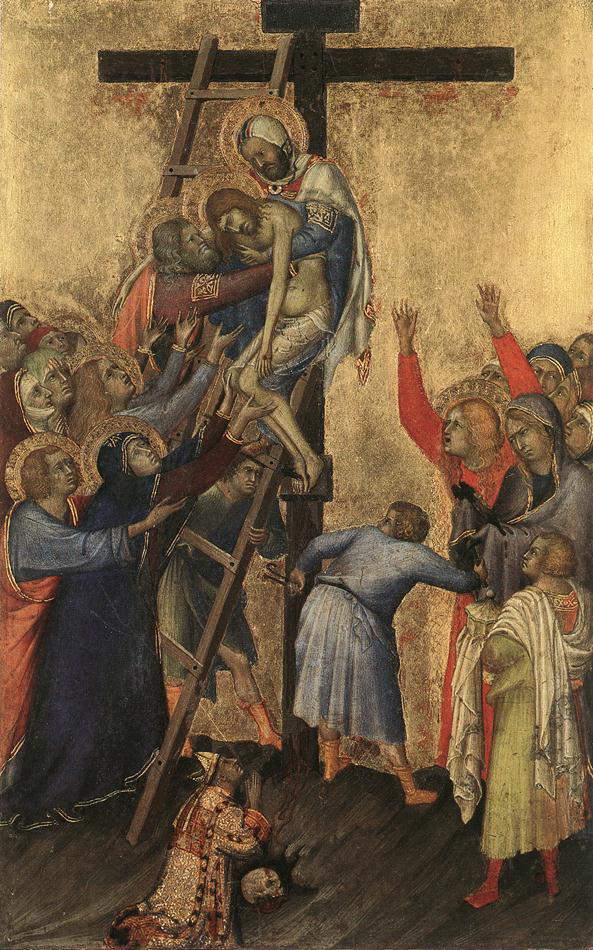 |
| Simone Martini, Deposition, from the Orsini Polyptych (1333-1335; tempera and gold on panel, 29.5 x 20.5 cm; Antwerp, Koninklijk Museum voor Schone Kunsten) |
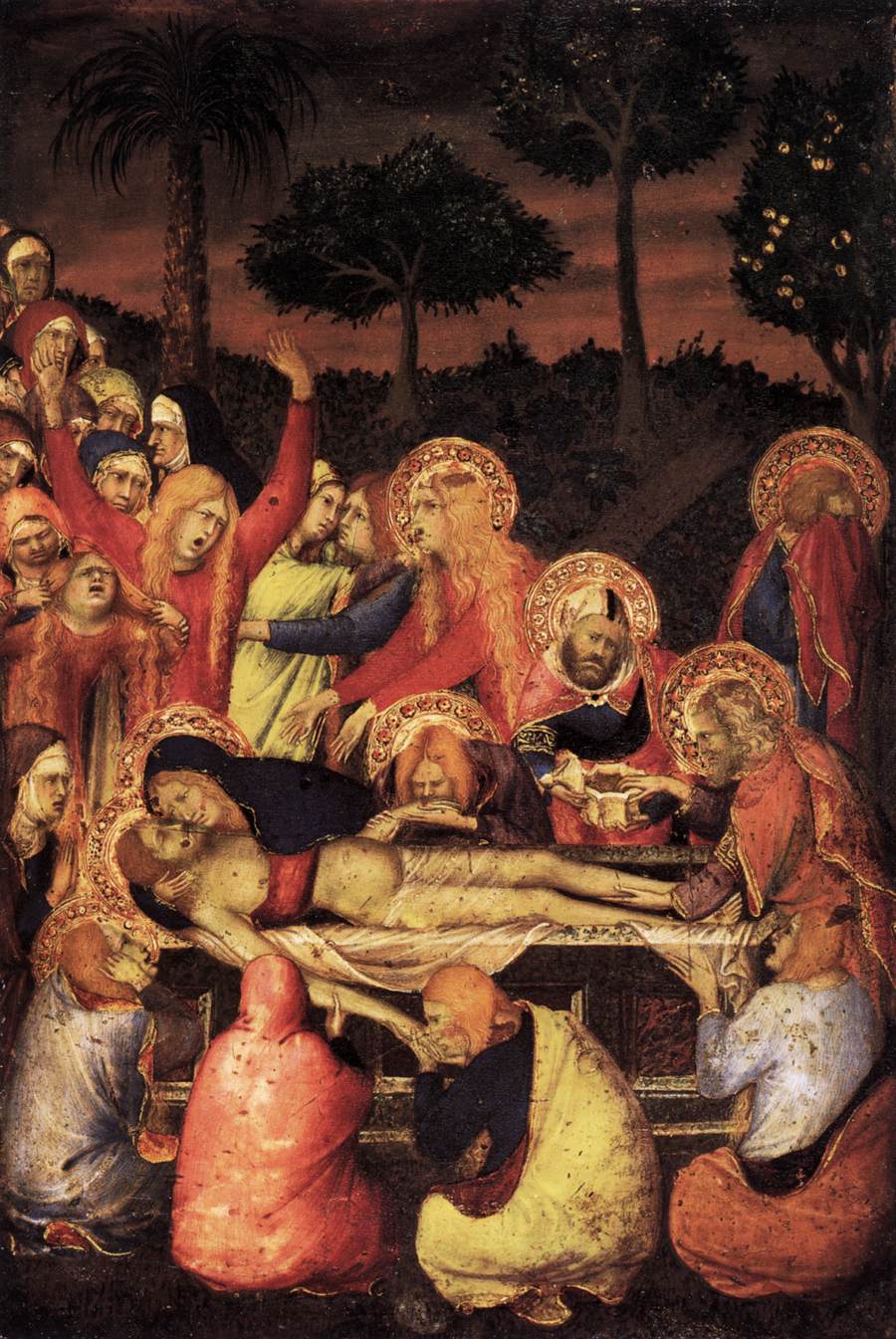 |
| Simone Martini, Burial of Christ, from the Orsini Polyptych (1333-1335; tempera and gold on panel, 29.5 x 20.5 cm; Berlin, Gemäldegalerie) |
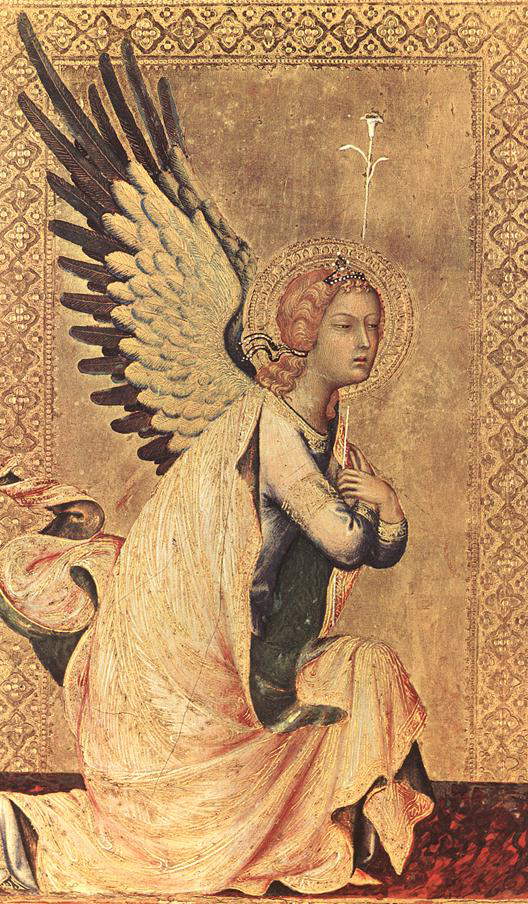 |
| Simone Martini, Announcing Angel, from the Orsini Polyptych (1333-1335; tempera and gold on panel, 29.5 x 20.5 cm; Antwerp, Koninklijk Museum voor Schone Kunsten) |
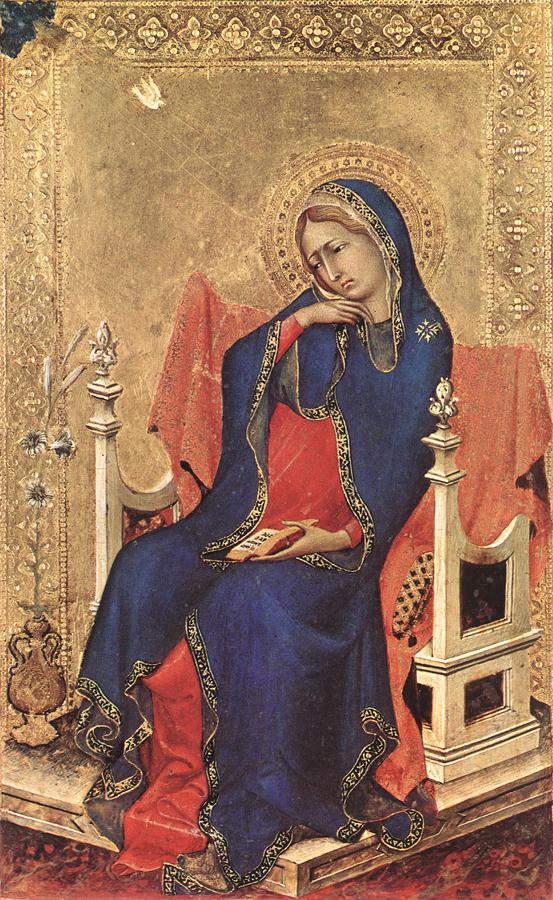 |
| Simone Martini, Virgin Announced, from the Orsini Polyptych (1333-1335; tempera and gold on panel, 29.5 x 20.5 cm; Antwerp, Koninklijk Museum voor Schone Kunsten) |
The architecture is depicted with great precision by Simone: the care with which the decorated mullion of the mullioned window is depicted in one of the rearmost buildings is remarkable. It is a scene full of pathos, and the painter pays great attention to the rendering of the emotions of the characters depicted. In addition to the blatant gesture of despair of Magdalene, who stands out with her long loose hair and red robe in the crowd, the meeting of glances between Christ and his mother is memorable. Mary has her mouth half-closed and seems unable to make any sound, while on her son’s face the sorrow for the pain he is causing his mother to feel shines through: in the excitement of the scene Simone creates a moment of great humanity.
In the Crucifixion and Deposition tablets, the cross is the element that dominates the scene. The composition seems to drown in the gold background, and again the spatial setting is not consistent throughout. The painter’s main intent appears to be to be able to bring out in the little space he has available the emotional aspect of what he represents, through the expressions and gestures of the characters. Simone uses a thin, elegant line to outline the faces and bodies of his figures: it is with this line and a skillful use of chiaroscuro that the painter renders the suffering of Christ’s body on the cross. Of this Christ, the reddish color of his hair stands out, a characteristic that would find much favor with the painter Matteo Giovannetti, one of the principal interpreters of mid-14th-century painting in papal Avignon. The composition is richly decorated: for example, the soldiers’ uniforms feature precious gold decoration.
In the Deposition panel, whose compositional layout is very similar to that of the Crucifixion, the element that has caught the attention of many scholars is the presence of a figure in an attitude of devotion at the foot of the cross, near Adam’s skull. Simon here depicts the patron: he has reduced proportions compared to the other characters, as his presence is not real in relation to the events depicted, but rather of devotional participation in them. The presence of the coats of arms of the Orsini family, visible when the polyptych is closed, is an unmistakable indication of this character’s family affiliation, and the dalmatic and mitre he wears can provide us with indications regarding his ecclesiastical rank. Identifying which member belonging to the Orsini family is represented here is by no means simple. In the complex matter of identifying this personage, the writer believes that the main suspects are two: Napoleone, from 1288 cardinal deacon of Sant’ Adriano, who died in 1342, and Giovanni Gaetano, from 1316 cardinal deacon of San Teodoro and papal legate in Tuscany from 1326 to 1336, who died in 1339.
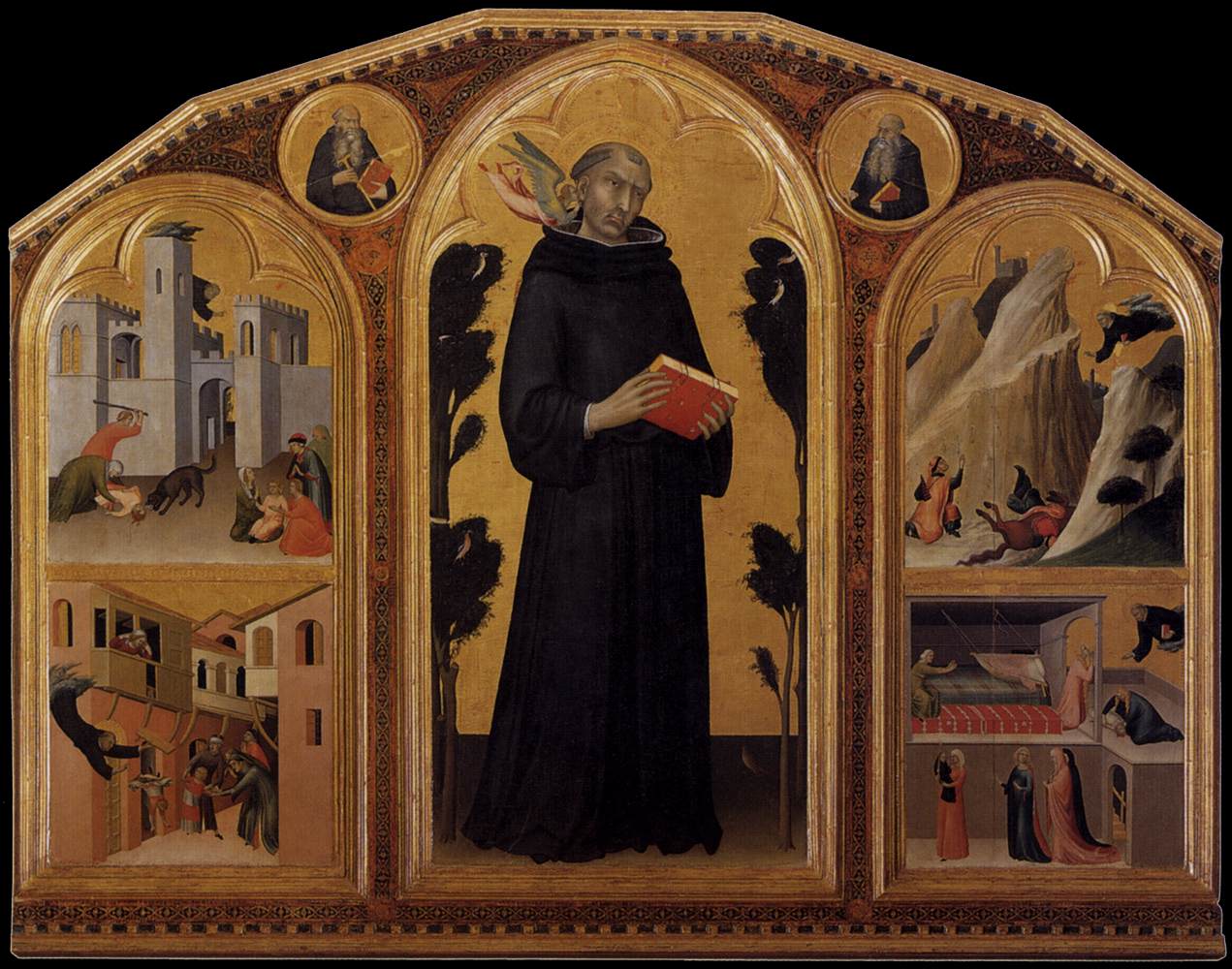 |
| Simone Martini, Altarpiece of Blessed Agostino Novello (1324; tempera and gold on panel, 198 x 257 cm; Siena, Pinacoteca Nazionale) |
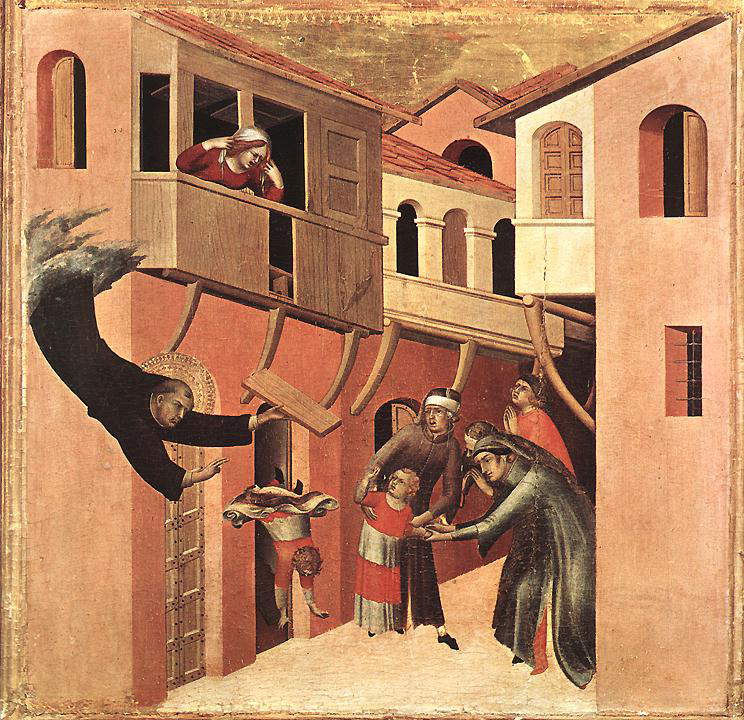 |
| Simone Martini, Altarpiece of Blessed Agostino Novello, detail of the child falling from the terrace |
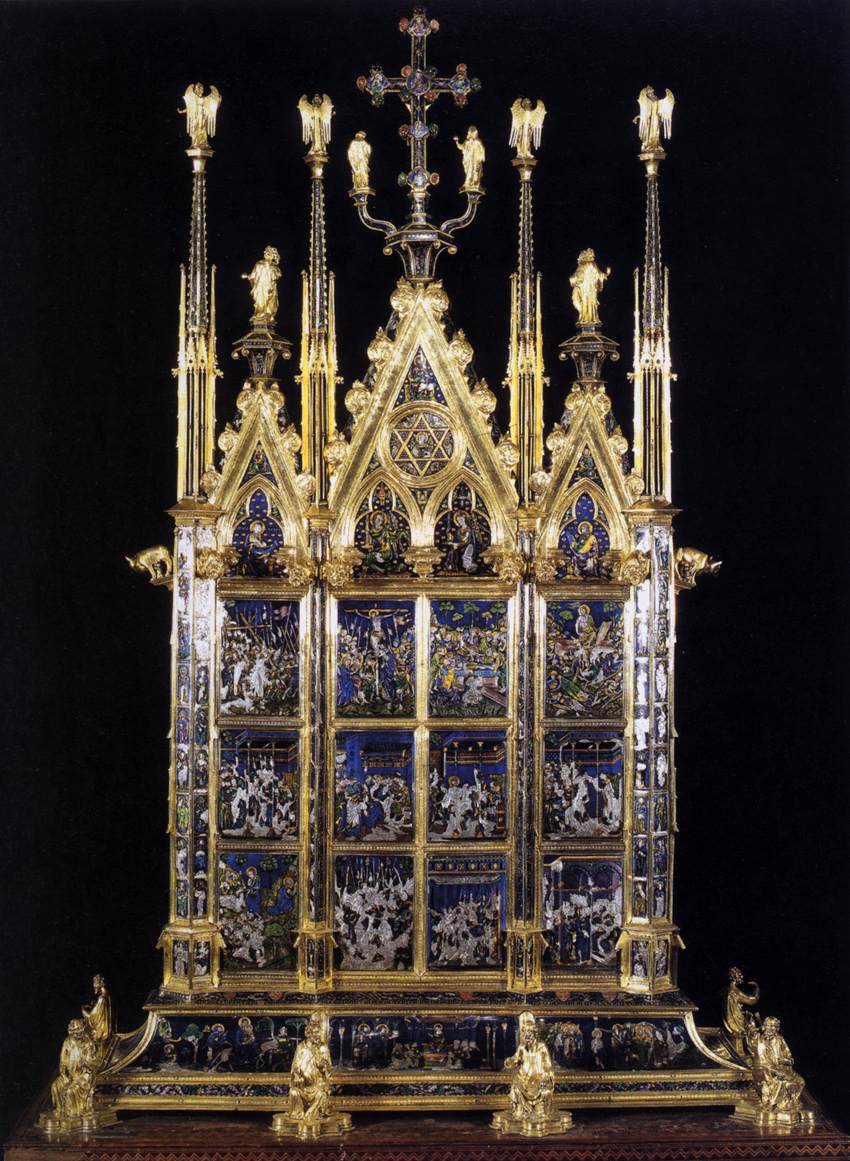 |
| Ugolino di Vieri, Reliquary of the Corporal (1337-1338; enamel on silver with silver statues, height 140 cm; Orvieto, Duomo) |
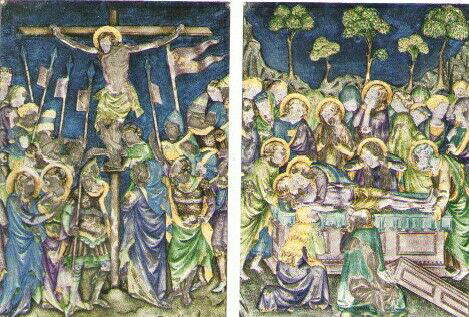 |
| Ugolino di Vieri, Reliquary of the Corporal, detail of the Crucifixion and Entombment |
Many art historians have wanted to recognize Cardinal Napoleone Orsini in the depicted subject. A certain link between Simone and Napoleon is a lost, but surviving portrait that the painter painted during his stay in Avignon. Napoleon Orsini linked his name to important artistic commissions: he was the patron of the chapel of St. John the Baptist in the Lower Basilica of St. Francis in Assisi, and one of the first patrons of Pietro Lorenzetti. In Avignon he commissioned the painter Matteo Giovannetti to decorate his residence. The commission therefore of this polyptych would not be foreign to the environment of artistic protection dear to Napoleon. Another element that inclines several scholars toward attribution to Napoleon is his connection with the Franciscan milieu, which from its founder made the themes of the Passion and Death of Christ one of the central points of its meditation. A work like theArbor vitae crucifixae Jesu Christi by Ubertino da Casale, who was Napoleon’s chaplain, fits well with the dramatic tone of this polyptych. Beyond the difficult identification, it remains crucial to understand its presence: the patron, by having himself represented at the foot of the Cross, makes himself a participant in those events, and through meditating on them, he may be a sharer in the salvation that ensues, with an approach proper to the Franciscan context.
In the fourth and final panel, the Burial of Christ is depicted. Once again Simon amazes with the incredible variety with which he manages to characterize the grief reactions of the various characters. In fact, at opposite ends of the composition, the painter places two different types of reaction. On the left, in the midst of the crowd, two women make blatant gestures to express their grief: one raises her arms toward the sky and has her mouth wide open as if she is screaming, while the other has her hands in her hair as if to tear it out, and is grabbed by the arms by a figure behind, as if to freeze her in that gesture of total heartbreak. This precise gesture of tearing out her hair is taken up by Simone from another of his works: one of the side scenes of the hagiographic panel of Blessed Agostino Novello, preserved in the Pinacoteca Nazionale in Siena, specifically The Miracle of the Child Falling from the Terrace. This blatant reaction is contrasted on the opposite side by an isolated figure, that of Saint John. Despite the fact that he covers his face with his cloak, we can imagine the grimace of pain hidden in it. The originality of the background of this scene has been much debated. The atmospheric sky, which almost resembles the hues of a sunset, is certainly not original and thought out by the painter. Instead, it must be found that the nature, which is also sometimes disputed, was instead already planned in the initial composition, even allowing for some later retouching. Supporting this hypothesis is the comparison with the Reliquary of the Corporal, exhibited in the Cathedral of Orvieto, made by Ugolino di Vieri: in the similar scene of the Burial of Christ some trees are depicted, although in a more synthetic manner. Simone Martini demonstrated on other occasions a particular attention to depicting nature: for example, in the already mentioned altarpiece of the Blessed Agostino Novello, three different types of plants are painted next to the figure of the saint, in such an accurate way that it is possible to recognize their type. Another clear example is the miniature for the frontispiece of theAeneid preserved in the Biblioteca Ambrosiana in Milan.
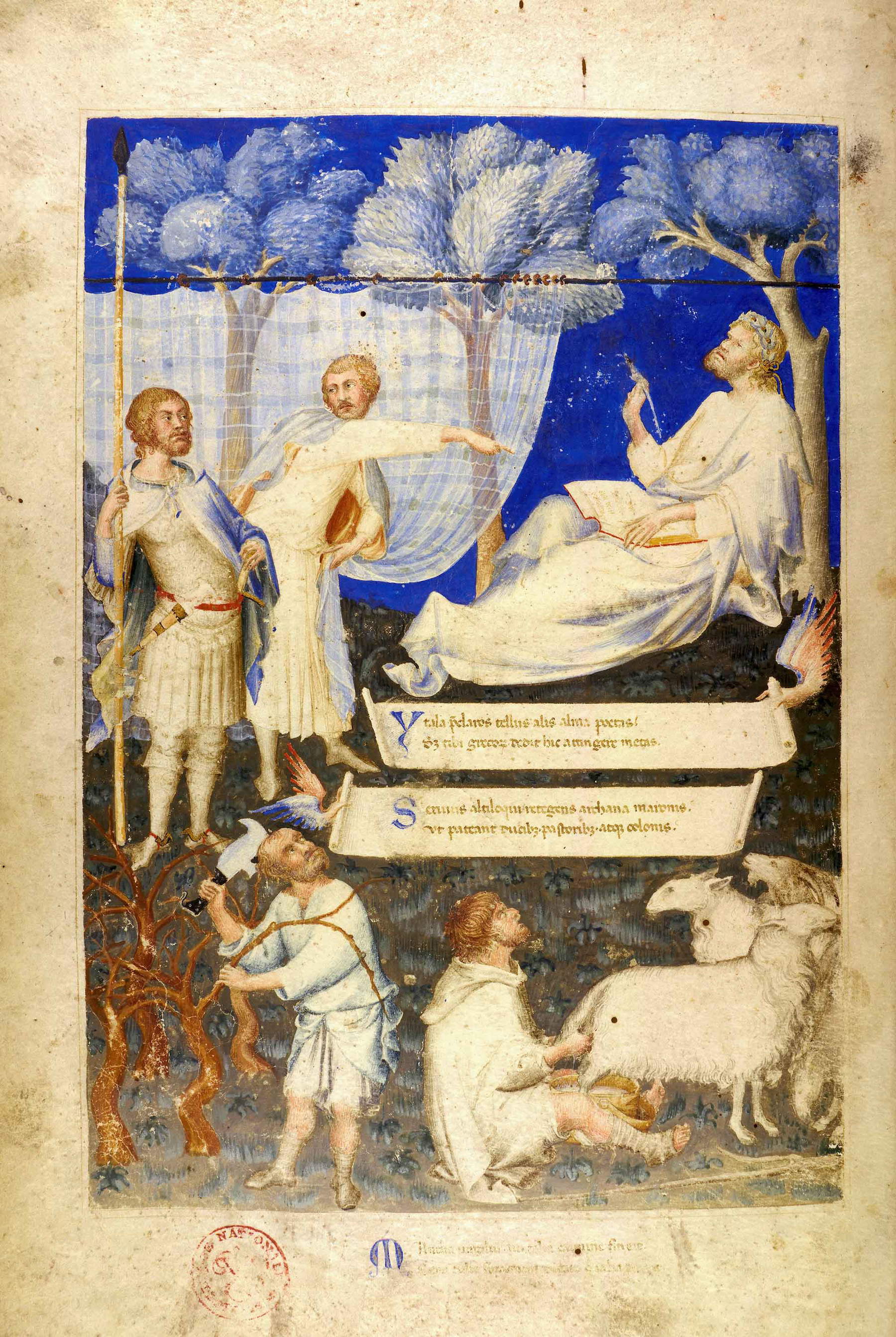 |
| Simone Martini, Virgilian Allegory, Frontispiece of Servio’s Commentary on Virgil (1340; tempera and watercolor on parchment, 20 x 29.5 cm; Milan, Veneranda Biblioteca Ambrosiana) |
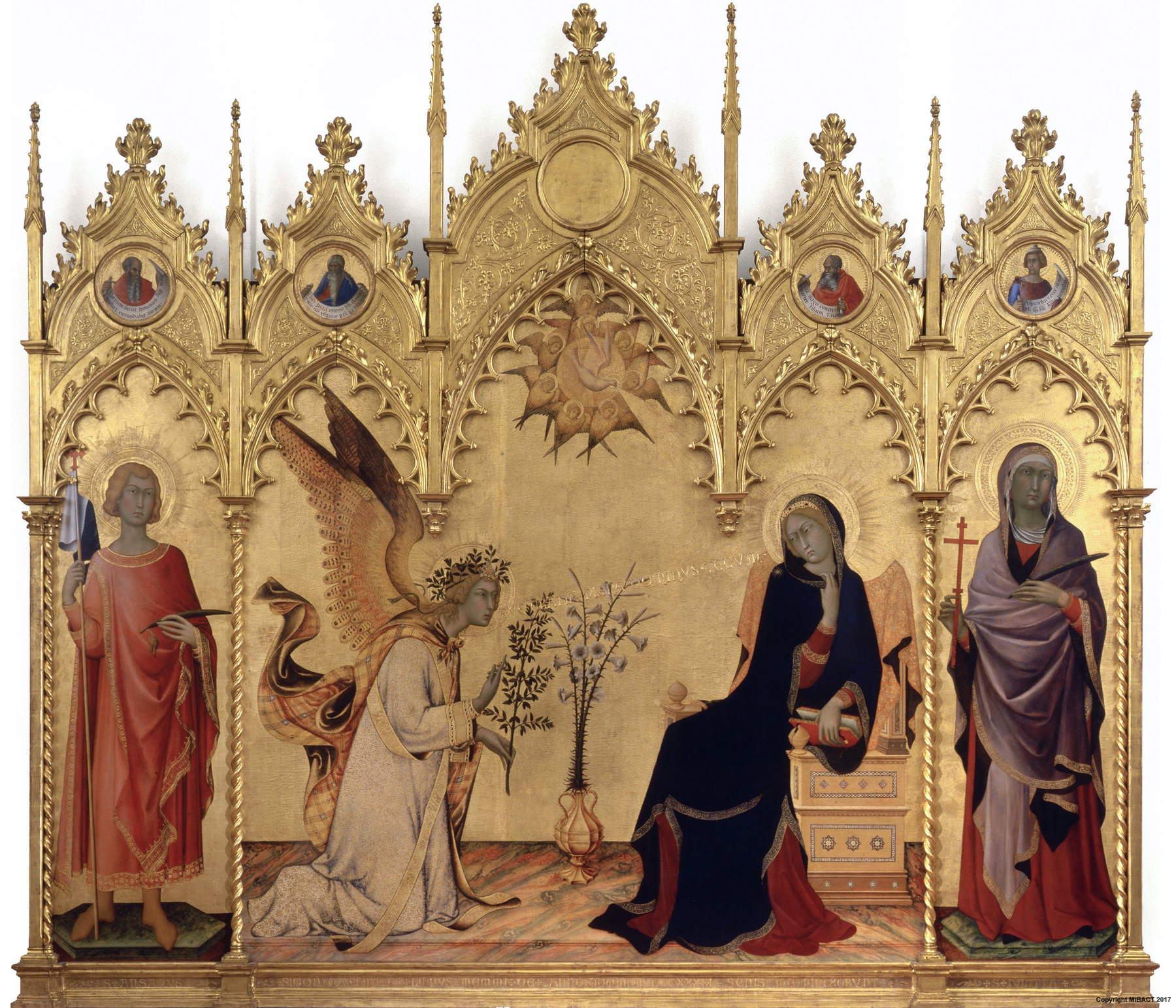 |
| Simone Martini, Annunciation (1333; tempera and gold on panel, 184 x 210 cm; Florence, Uffizi) |
The atmospheres of these scenes turn out to be extremely refined, thanks to a subtle and elegant line, the ability to control chiaroscuro and chromatic subtlety. Many scholars have recognized in the characters of this work a model of influence for the development of a certain taste, elegant and somewhat fabulist, that would develop at the Franco-Flemish courts and would later be decisive in the initiation of that artistic phase called International Gothic or Late Gothic.
The Orsini polyptych is a work that is not easy to read chronologically, and no documentary evidence is known to help set a possible date.
As mentioned earlier, in this work Simone Martini’s overall management of space, so well implemented in the altarpiece of the Blessed Agostino Novello, seems to be lacking with respect to the progressive course of Simone Martini, although we note that some very precise spatial references are maintained. The painter carried out a similar operation in one of his most famous works, the panel of theAnnunciation painted for the altar of St. Ansano in Siena cathedral, and now in the Uffizi in Florence, dated 1333. Indeed, in the latter work, alongside the powerful abstract character that seems to characterize the figures of the Virgin and the Angel, some elements, such as the vase and the throne, have a full spatial consistency. If we look at theAnnunciation of the Orsini polyptych, there are several details that are indicative of spatiality: from the most obvious ones, such as the marble throne, to the more intimate ones, such as the book held in the hand of the Virgin announced. Given this process, it is possible to assume that this work is one of the last ones made in Siena by Simone Martini before his move to Avignon in 1335.
Warning: the translation into English of the original Italian article was created using automatic tools. We undertake to review all articles, but we do not guarantee the total absence of inaccuracies in the translation due to the program. You can find the original by clicking on the ITA button. If you find any mistake,please contact us.